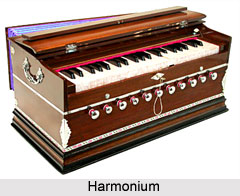 Harmonium is most widely known and used free-reed aero-phone in India, though the eminent ones are also the mouth-organ and the accordion. There are indeed various types of harmonium and mostly they have been imported from the West and the harmonium was perhaps introduced into this country in the late nineteenth or the early twentieth century. The uses of harmonium find a place in the music of all kinds - folk, light, dramatic and even the highbrow.
Harmonium is most widely known and used free-reed aero-phone in India, though the eminent ones are also the mouth-organ and the accordion. There are indeed various types of harmonium and mostly they have been imported from the West and the harmonium was perhaps introduced into this country in the late nineteenth or the early twentieth century. The uses of harmonium find a place in the music of all kinds - folk, light, dramatic and even the highbrow.
History of Harmonium
The actual origin of harmonium goes back a long way. It has freely moving reeds (as well as rising reeds) on which a patent was taken out in 1840 by the French instrument maker, Alexandre Debain. The history of harmonium speaks at great length about the extreme popularity the instrument in places like United States and Europe in the second half of the nineteenth century, used mainly for accompanying the voice in the home and in church, since it had the tone of a pipe-organ without the bulk or the enormous expense. The harmonium was introduced in India by the missionaries who brought these percussion instruments in the nineteenth century. Since the instrument was portable and easy to learn and handle, it became quickly popular. In many genres of Indian music, especially, North Indian music, harmonium plays an important role. However the instrument was modified later keeping in mind the Indian need. The harmonium used in India is a hand held one and is generally played by keeping it on the floor. While with one hand the musician played the melody, he used the other hand for the bellows. Besides music, harmonium in India carved a place for itself on stage as well. Especially, in Parsi theatre and Marathi theatre it was widely used, and also in Modern Bengali theatre. The role of the harmonium was usurped to some extent by the electric organ in the second half of the twentieth century, though not for religious music.
Construction of Harmonium
The process of construction of harmonium has a lot of similarity with that of piano. This instrument, as a result, has a piano-like body, often elaborately carved in the fashion of the day. The basic and functional parts of a harmonium are two: the reed and the air bellows. The first is the real tone producer; the latter with all its attached valvular mechanisms produces and controls a current of air under pressure. It has two foot-pedals connected to two bellows that provide the air supply. The keyboard has a range of five octaves. Below the keyboard, on the more elaborate instruments, there are two siphon paddles operated by the player`s knees. One initiates a sort of swell mechanism while the other is used for musical emphasis like a general crescendo.
The sounding part of the harmonium is a set of reeds, one for each note. The reed is made of brass, consisting of a frame with an oblong shallot. Moving in this gap is a thin metal tongue, the reed, which is fixed at one end and free at the other. Till recently high quality reeds were imported from France and Germany; but nowadays good ones are produced in India, particularly at Palitana in Gujarat.
Playing of Harmonium
Some harmoniums push the air and others use suction. The European instruments tend to use pressure, the suction instruments were developed in the United States. In each case, the keyboard is divided into bass and descant sections. Registers are available through "coupling" in just the same way as on pipe-organs. Simple harmoniums have only one register but the larger and more elaborate instruments have up to eleven. When the bellows are worked, air gets compressed in the wooden box below the reeds. The pressurised air is allowed to go across a reed by opening a hole under it. This is done by depressing a key on the keyboard which action moves a valve at the opening under the reed. On the opening of this valve, air rushes past the reed making it vibrate and give the required tone. When the finger is lifted off the key, a spring brings it back to its original position and the aperture below the reed gets closed.




